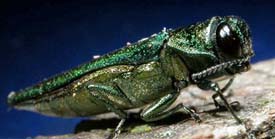| Maryland Newsline |
| Home Page |
Politics
|
Meet the Beetles: Emerald Ash Borer in Prince George's Threatens State
Capital News Service Thursday, March 11, 2004 WASHINGTON - State officials have destroyed nearly 600 trees and will cut at least 500 more to stop a parasitic Asian beetle that, if left unchecked, could exact $227.5 million in losses from Baltimore-area greenhouses and nurseries alone. The emerald ash borer was discovered last April during a routine Maryland Department of Agriculture inspection of a nursery in Brandywine. Officials had been on the lookout for the beetle, which has killed more than 6 million trees in Michigan since it was found there in 2002. "This is probably one of the worst actors that has hit the United States," said Dick Bean, a state Agriculture Department entomologist. "It's more injurious than the gypsy moth. There's the Asian longhorn beetle, that's pretty bad. But I think this one is more injurious." The state and the owners of Ed's Plant World, where the borer was discovered, have burned most trees from a shipment of 121 that came from Michigan. Plant World manager Paul Morin estimates that 95 percent of those trees have been found and destroyed -- but some are still unaccounted for. Morin has also helped state officials burn another 389 trees at his nursery and is working to find ash trees recently sold to customers. Bean said the state plans to destroy all the ash trees within a half-mile radius of Ed's Plant World, at least 500 trees. Bean said the state has "until about April 15" to clear out any infested trees before the beetles emerge and mate. "It's the most serious thing that I've had to deal with in the 27 years that I've been working for the state," Bean said. "If we do our job now we won't have to expand our job out and have to keep moving this half-mile buffer around." He said officials recovered 89 trees from Ed's Plant World at 13 different sites, and found larvae in 15 of the trees. That is more than enough larvae "to start a raging population," the department said in a prepared statement. Each female lays 60 to 90 eggs, said Bean. Larvae in just one tree can multiply to dozens, then thousands. "We really have to act now to prevent the emerald ash borer from . . . becoming established in Maryland," said Julie Oberg, an Agriculture Department spokeswoman. She said that anyone who bought an ash from Ed's Plant World between April and September should contact the department as soon as possible. Cleaning out the trees in Brandywine "is going to take a fairly large, well-coordinated crew," Bean said. The state is getting help from crews from utilities, park departments and other county and state agencies. "And, it's not over once we cut the trees," he said: The state will monitor the trees for years to come. Officials think the ash borer reached the United States five to seven years ago in wooden packing material from China. The beetle was first detected in July 2002 near Detroit. Thirteen Michigan counties are now under a quarantine that prevents movement of all ash-tree material within and from those counties. Ed's Plant World bought the tainted ash trees from a seller in Tennessee, who had bought them from a grower in Michigan. The Michigan seller has since been convicted on charges of evading a federal quarantine, Morin said. "It was just a $10,000 sale that created this entire problem," Morin said, adding that the Michigan man later flew to Maryland to personally apologize to the owner of Ed's Plant World. "I think he had realized that he had not, you know, done a little 'whoops,' but had created a huge problem," Morin said. Bean was not quite so forgiving. "Shoot my cow and then apologize. Yeah, thank you," he said. Morin said his nursery has been working, at its own expense, to make sure Maryland does not face the same fate as Michigan. "We've definitely incurred quite an expense to track everything down," he said. "But we're OK with that because we don't want this to spread." Ash trees grow abundantly in Western Maryland forests and are among the most popular landscaping trees in the country. But Morin said he and other nurseries in the state now steer customers away from the trees. Oberg said it takes about a year for an ash to show signs of borer infestation. First the upper third of the tree will thin and die back, then shoots sprout from the trunk. Next, D-shaped exit holes appear in the bark where adults escape, the bark splits and serpentine tunnels under the bark develop where larvae have stopped food and water movement inside the tree, starving it to death. Bean said the state will plant about 60 ash trees near Ed's Plant world as bait for any chance beetles flying around. Those "sacrificial trees" will be painted with a sticky substance to trap the beetles. "We can all breath a sigh of relief," if no beetles have been found on the bait trees by the end of spring, Bean said. But nothing is foolproof, and agriculture officials will continue testing for the next few years. "You can put out traps for things, but you may or may not always get your target," Bean said. Copyright © 2004 University of Maryland Philip Merrill College of Journalism
|

